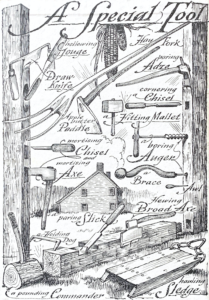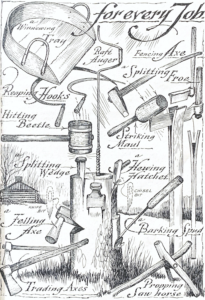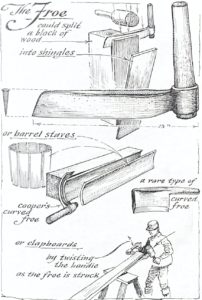Implements of Trade
“A tool is but the extension of a man’s hand.”
– Eric Sloane in A Museum of Early American Tools (1964).
In colonial times, tools were designed by the craftsmen who used them. Knife-blades, plane blades, and axe heads were made by the iron worker and the craftsman would make his own wooden handle.
The objects in the Tools and Trades of Bethabara Exhibit, located in the barn, are representative of the implements that would have been used by the tradesmen of Bethabara in the late 18th century. Inside the barn, you will find all of these objects and more for you to explore. Each item in this exhibit can be found in the barn, located under its trade name and numbered. All illustrations on this page were created by Eric Sloane and featured in his books, A Museum of Early American Tools and A Reverence for Wood. This online exhibit was adapted from an exhibit originally designed in 1996 by Richard C. Worf as an Eagle Scout project and was researched by Worf and Dewey Yarborough.
WHEELWRIGHT
The wheelwright was not just a maker of wheels. He also made wagons, carts, ploughs, agricultural implements, hay rakes, and many other things needed by the village and surrounding farms. In addition, the wheelwright often supervised the felling of local trees, and when a millwright was not available, the wheelwright was called in to repair windmills and watermills.
- The Traveler: This unusual-looking implement was for measuring and transferring the lengths of objects. The wheel in the fork of a short handle was marked with chalk. The operator noted the location of this mark while running the wheel along a certain length. He would count the number of revolutions the wheel made and then reproduced that same number on the second object. Wheelwrights and coopers used travelers to determine the lengths needed for difficult to measure tires and iron hoops.
JOINER
The word “joiner” first appeared in the Oxford English Dictionary in the late 14th century. As improved tools and methods made possible the making of furniture and house fittings from smaller sections of wood joined together into frames, the art of the joiner became separated from that of a carpenter. The joiner made sash windows, staircases, and paneled walls and ceilings. Mouldings became important and moulding planes became a distinctive feature of the joiner’s kit.
- The Drawknife: The drawknife came to American before the Pilgrims. Used to taper the sides of shingles, to right-size the edges of floorboards and rough-trim paneling before planing them, the drawknife was used in conjunction with the shaving horse. This allowed the worker to use both hands. It was also used to fashion axes, rakes, and other tool handles, and to make stool legs, ox yokes, pump handles and wheel spokes.
- The Chisel: Chisels for woodworking have been used since the Stone Age. In the colonial period, chisels had metal blades with hand-made wooden handles. There were many types of chisels, but their basic function was to cut wood away in order to perform the next step in the creation of something. Forming chisels were used to cut the extra wood from two auger holes to make a mortise. A mortise is a rectangular cavity in a piece of wood. A framing chisel, as on display here, is a heavier version of a forming chisel and was used largely in the cutting of tenons, the projections on the end of a piece of wood intended to fit mortises. The corner chisel, as pictured here and on display, would have been used to form and smooth right-angled cuts. The age of the blade on the displayed corner chisel is unknown, but the handle is likely from the 1940s.
- The Froe: The froe was used in many different trades for splitting timber lengthwise into boards, segments, or billets. It had a blade about 6-12 inches long and round socket for the handle, which was set at right angles to the cutting edge. Froes were often used to make shingles.
- The Bow Saw or Turning Saw: “Bow saw” is a name given to small frame saws and, in particular, to those in which the blade is tensioned by means of a twisted cord and toggle stick. The blade is held between the lower ends of wooden sidepieces and is kept in tension by the cantilever action exerted when the top ends of the sidepieces are drawn together by a cord. Although not present in the displayed version, a stick was used to hold the turns in the cord. Our example is from the late 1800s or early 1900s.
- The Moulding Plane: Moulding planes were used for decorating the moulding around doors and windows, details of cabinetwork, skirtings, picture frames, etc. Since about 1770, the size and shape of moulding planes have been more or less standardized. The stocks are 9.5 inches long.
- The Mortise and Tenon Joint: The mortise and tenon joint is used in framing, furniture, buildings and in many trades. The end of one part is prepared as a tenon (or tongue) designed to fit into a mortise hole made in the other part.
- Coffin: Coffins like the one on display were commonly found in the joiner’s shop for sale. While most Moravians were buried in plain rectangular boxes, wealthier people might have purchased this style hexagonal coffin from the joiner.
CARPENTER
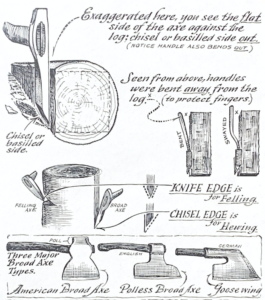 Up to the end of the 16th century, the master carpenter was considered the leading tradesman in the wood industry. Carpentry was usually carried out on site and concerned comparatively large timbers nailed or pinned together or framed up with simple joints.
Up to the end of the 16th century, the master carpenter was considered the leading tradesman in the wood industry. Carpentry was usually carried out on site and concerned comparatively large timbers nailed or pinned together or framed up with simple joints.
- The Adze: An ancient tool, the adze was used to make surfaces, such as exposed parts of hewn logs, smooth. The adze left no scoring marks, as an axe or broadaxe did. The blade was positioned broadside to the handle; the metal portion had to be removable to enable sharpening. Our example is a Paring Adze.
- The Mallet: Mallets are hammers made of wood. They were used to drive wooden objects that would fracture if struck with a metal hammer. Wooden mallets were used to pound wooden nails and chisels with wooden handles.
- The Auger: Augers served two purposes: making and enlarging holes. The blade is arranged in a spiral around an imaginary vertical shaft, and a wooden handle lies across the top for gripping. The spiral both cut and removed wood. A user of an auger had to put his or her entire weight on the handle to give the tool enough cutting force–this was, consequently a very tiring task. Twist augers became common in the late eighteenth century.
- The Trimming or Pruning Saw: Pruning saws were used in the garden and orchard for pruning fruit trees.
- The Chisel: Chisels were used to cut wood. They came in a great variety of sizes and shapes. Most chisels were designed to be hit with a mallet.
- The Square: Squares were used for marking out, for testing the accuracy of workpieces, and for testing the angle of structures in building work. Though factory-made from the 18th century onwards, those found in the older workshops were often made of wood by tradesman and differ little in appearance from the squares that have survived from ancient Egypt and Rome. The square in our display is a 1930s tri-square.
- The Brace: The brace was a tool for boring, consisting of a chuck or pad for holding the bit at the foot, a head at the top for a handhold, and, between the two, a crank for rotating. Our example is a Plated Sheffield brace that dates from the late 1800s.
- The Broad Axe: The broadaxe turned a round log into a square or rectangular beam. It had a large head, more than twice the size of a felling axe. The use of the broadaxe required a great amount of skill and brute strength. The broadaxe left rough marks on the log, which were then smoothed with an adze.
- The Workbench: The workbench was the most versatile and useful tool that a craftsman possessed. It was carefully constructed to fit the needs of the individual and to allow free motion during the various procedures that he had to carry out. It also held many of the carpenter’s tools. A vise was a type of large clamp. One type, pictured here at the lower left corner, can be found on the workbench. The other type is the box vise, which was built as part of the workbench.
- The Shaving Horse: The shaving horse was a low bench, supported on splayed legs, on which the operator sat astride. The pedal-operated jaw held the work, thus leaving both hands free for shaping the workpiece, usually with a drawknife. Shaving horses were used in many trades, perhaps most commonly by coopers, chairmakers, and shingle makers, who often had to produce thousands of shingles.
- The Plane: A plane was used to flatten or level a piece of warped or untrue wood through cutting. Colonial planes were constructed from a block of straight wood with rectangular blade positioned at a certain angle within. The angle at which the blade was placed determined the depth of the cut. Planes came in every size, from less than one inch to over six feet in length.
- The Maul: The maul was a very heavy and hard piece of wood, not necessarily round and sometimes cut directly from a large root, which was attached to a crude handle. They were used to drive wedges into logs to split them.
FARMER
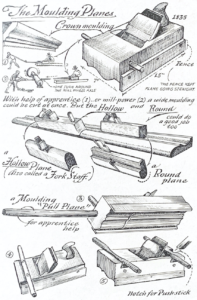 A farmer was a person who engaged in agrarian business by using land. The term farmer usually applied to a person who grew field crops, or had orchards, vineyards or market gardens. Farmers were also involved in rearing cattle for meat or milk. The term dairy farmer was applied to those engaged in milk production. A poultry farmer was one who concentrated on raising chickens, turkeys, domesticated ducks, and geese or was involved in egg production.
A farmer was a person who engaged in agrarian business by using land. The term farmer usually applied to a person who grew field crops, or had orchards, vineyards or market gardens. Farmers were also involved in rearing cattle for meat or milk. The term dairy farmer was applied to those engaged in milk production. A poultry farmer was one who concentrated on raising chickens, turkeys, domesticated ducks, and geese or was involved in egg production.
- Fingered Cradle Scythe: This is a beautiful example of a Four-finger cradle scythe. The farmer would have used this implement to cut grain, hay, or grass. He would have “cradles” the cuttings and then dropped them in a central location. Our example is hand-made and from the 19th century.
- The Scythe: Grasses and grain crops were cut down by hand using a scythe, which is a long, curved blade with a wooden handle. Our example is hand-made and from the 19th century.
- The Flail: Since biblical times, farmers have been using flails to thresh grains. A flail consisted of a long wooden handle and swung the pole by a leather strap. The farmer held the handle and swung the pole down onto the sheaves repeatedly to knock the grain off the stalks. A man in good health was able to give the sheaves thirty to forty strokes a minute.
- The Rake: Rakes were used in colonial times, as they are today, to handle and move hay and other straw-like grain stalks.
- The Hoe: The humble hoe was used to break up and otherwise move soil in agricultural applications. Whereas the plow could work large tracts of land, a hoe was a hand tool that found employment on a smaller scale.
- Well Pulley: A well pulley is a simple machine consisting essentially of a wheel with a grooved rim in which a pulled rope or chain can run to change the direction of the pull and thereby lift a load. Our example is a well pulley from the 1930s.
- The Plow: Plows were used to turn the soil before seeds were planted. The seeds needed to be fully enclosed within soil in order to germinate The blade, which actually turns the soil, is called the “share.” A single horse or mule drew our two examples of plows.
- The Flax Brake: The flax brake was a mechanism for extracting the linen fibers from rough straw. As the raw flax was shuttled through the holding portion of the brake *the wooden box part), the metal handle would be swung down repeatedly upon it, cracking the woody outer shell of the straw. The product could then be carded and filtered to yield the linen, in preparation for spinning.
- The Vat: This copper-bottomed vat would have been used for scalding hogs. After the hog was slaughtered and gutted, it was put in hot water and the hair was removed from the body. This vat dates from the 1940s.
WAINWRIGHT
Wainwrights made wagons. A wainwright was also probably a wheelwright, as the wheels were the most difficult part of the process of wagon-making. The wheelwright held the key to the successful geometry of the wagon. If need be, he could make the whole wagon himself, otherwise he was foreman to a smith and wrights who specialized in making the undercarriage and the body of the wagon. Working on his own, it would take a wainwright several months to build a wagon. Conestoga Wagons were built in this area by the Nissen Wagonworks, which began operations in Salem in 1881 and remained in the business of building wagons until after World War II.
Conestoga Wagon
Conestogas were used throughout the 19th century as a reliable, rugged, and repairable farm and freight wagon, especially along the Great Wagon Road that ran through the Shenandoah Valley into Piedmont North Carolina. Most Conestogas were pulled by four to six horses in two rows. The Conestogas had large wheels to cross streams and even out bumps, removable hubcaps for easy wheel access, and a double fork system for smoother turning. They also had a slanted bed to move heavier articles towards the center of mass, bows to support a cover that protected the goods inside, and even a feed through hung on the back for horses. The Conestoga was an engineering masterpiece.

